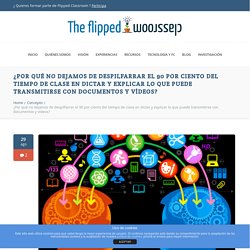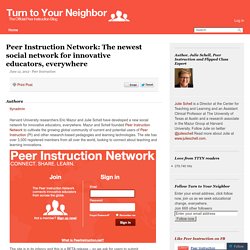

¿Por qué no dejamos de despilfarrar el 90 por ciento del tiempo de clase en d... Es para nosotros un placer trascribir esta reflexión de Alfredo Prieto Martín, ubicada originalmente en su BLOG.

Alfredo es Doctor en Biología e imparte docencia en Biología y Biología sanitaria en la Universidad de Alcalá. Muchas gracias a Alfredo y esperamos contar contigo para futuras colaboraciones en esta web. ¿Por qué no dejamos de despilfarrar el 90 por ciento del tiempo de clase en dictar y explicar lo que puede transmitirse con documentos y vídeos? Los medios para transmitir la información a nuestros alumnos sin gastar el tiempo de clase están a nuestro alcance gracias a Internet y se llaman: e-mail, pdfs, vídeos y podcasts de presentaciones animadas. El Ejercicio consiste en pedir a la audiencia de profesores que piensen sobre qué es lo que ocurre en un aula en la que un profesor está dando una clase magistral ¿Cuál es la actividad que se está produciendo ?
Tras una perplejidad inicial alguien dice “transmisión” ¿Que se está transmitiendo? “Hechos o información” "Flipped classroom" teaching model gains an online community. Cambridge, Mass. - February 8, 2012 - Researchers at Harvard University have launched the Peer Instruction (PI) Network (www.peerinstruction.net), a new global social network for users of interactive teaching methods.

PI, developed by Eric Mazur, Area Dean for Applied Physics and Balkanski Professor of Physics and Applied Physics at the Harvard School of Engineering and Applied Sciences (SEAS), is an innovative evidence-based pedagogy designed to improve student engagement and success. Mazur, famous for his talk titled "Confessions of a Converted Lecturer," developed the method after realizing in the 1990s that his physics lectures at Harvard, while popular, were not helping students to master the basic concepts. The PI technique relies on the power of the "flipped classroom. " Information transfer (i.e., a teacher transferring knowledge to students) takes place in advance, typically through online lectures. In short, students study before rather than after class. Peer Instruction Network: The newest social network for innovative educators,... Harvard University researchers Eric Mazur and Julie Schell have developed a new social network for innovative educators, everywhere.

Mazur and Schell founded Peer Instruction Network to cultivate the growing global community of current and potential users of Peer Instruction (PI) and other research-based pedagogies and learning technologies. The site has over 3,000 registered members from all over the world, looking to connect about teaching and learning innovations. The site is in its infancy and this is a BETA release – so we ask for users to submit suggestions, bugs, or wish-lists to here: PI is an interactive teaching method created by Eric Mazur that relies on the power of both the “flipped classroom” and social learning. In a PI course, information transfer or content coverage takes place in advance, typically through online readings, videos, and assignments before class meetings and information assimilation or content uncoverage happens during class.
Like this: Choreography of a flipped classroom. How do flipped classrooms work?

In a previous post, we wrote about a research-based strategy, Just-in-Time-Teaching, for motivating students to do the work of content coverage out of class. But, what happens in class? Peer Instruction (PI) is the researched-based method we use for targeting depth and uncovering misconceptions and misunderstandings during class. Peer Instruction Network member Bernado, who teaches Marketing in Mexico, asks, “how does PI work?” Mark, a high school chemistry teacher from Lexington wants to know: “How does one implement the process?
Tips for selecting pre-class activities Pre-class readings and videos are organized around common course topics, just as they would be in a traditionally taught course. You can begin to identify the difference between factual knowledge and understanding by asking yourself , “if students know the subject matter, what can they do with it? As part of their out-of-class work, students complete an online reading assignment. Like this: Readings to prep for flipping your classroom with Peer Instruction. It is a month before the semester starts and you want to try flipping your classroom using Peer Instruction in the Fall.

You’ve read the blog posts, gone through the Quick Start Guide, now are looking to snuggle up with a good journal article or two to do a bit more in-depth preparation. Here is a list of some of the readings we refer to most in our work here in the Mazur Group. (This list is not exhaustive by any means, but offers a great start). For a narrative overview of research on Peer Instruction, also check out the PER User’s guide article, What Does the Research Say? Peer Instruction Network Member Vagner Oliveira’s high school students engaged in a Peer Instruction question (Brazil) Journal/Magazine Articles How to Transform Learning – With Teaching Julie Schell, Leaders of Learners, 5, 3-5 (2012). Student-Centered University Learning: Turning Traditional Education Models Upside Down Julie Schell, ReVista: Harvard Review of Latin America, Fall, 20-23 (2012).